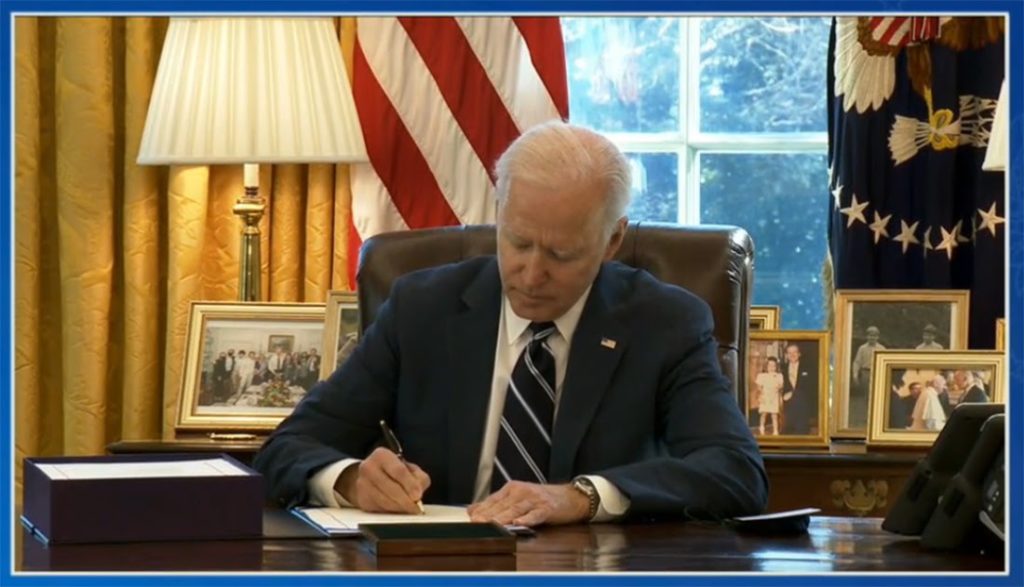Poli sci professor explains what the legislation means

SCREENSHOT TAKEN BY ROXANNA MIRANDA FROM THE WHITE HOUSE BILL SIGNING LIVESTREAM ON MARCH 11
Brigitte Ortiz | THE RIDER
President Joe Biden signed the $1.9 trillion American Rescue Plan on Thursday, which will provide eligible individuals with direct payments of $1,400 as early as this weekend.
“I believe this is, and most people I think do as well, this historic legislation is about rebuilding the backbone of this country and giving people of this nation, working people, the middle-class folks, people who built the country, a fighting chance,” Biden said in a White House livestream. “That’s what the essence of this is.”
On Wednesday, the U.S. House of Representatives approved the $1.9 trillion COVID-19 relief bill following a Senate version that had been passed with some changes, including new limitations on who would receive the third stimulus check.
Similar to the previous legislation, individual tax filers making up to $75,000 per year qualify to receive a stimulus check, which will be $1,400 this time around. Married joint filers making up to $150,000 will get $2,800. Recipients may also receive $1,400 multiplied by the number of dependents of the taxpayer for the latest tax return on file.
The new law will provide unemployment checks of $300 to qualifying Americans through September. The legislation will also provide funds for schools and institutions of higher education, COVID-19 vaccinations and agriculture and nutrition programs, such as the Supplemental Nutrition Assistance Program.
Daniel Chomsky, a political science associate professor at UTRGV, said the changes to the legislation are modest or fairly trivial.
“The original package was passed in the House and went to the Senate and in the Senate, the most conservative Senate Democrats, particularly Joe Manchin of West Virginia, demanded some changes,” Chomsky said. “The changes were actually quite modest. … There were a couple changes. The most important one was narrowing or lowering the income threshold for beneficiaries of direct checks.”
He said this package has a lot of advantages over the last one issued in December 2020.
“The December checks were worth about $600 per person; these are much more generous at $1,400 a person,” Chomsky said. “They slightly narrow the standard for when you would receive it or for who would receive it. That is, they lowered the income thresholds for beneficiaries but the change is not that dramatic.”
He said the reason for the changes is that the Democrats narrowly govern the Senate with a 50-50 split, with essentially a one-vote advantage because of Vice President Kamala Harris.
Chomsky said most Americans will still get these checks and the benefits are strongly geared to people with low and modest income. People at the bottom half of the income distribution are going to see a lot of benefit from these checks. If they’re at the very top, they’ll see nothing, the associate professor said.
He said the process of distributing the direct payments is going to be exactly like the first two rounds of stimulus checks.
The Senate also decreased the weekly unemployment benefits from $400 to $300.
Chomsky said the U.S. House of Representatives tried to increase the amount of unemployment benefits but was reduced to the standard that was set in the December 2020 round of checks, where it extended the supplemental on unemployment to $300 through the middle of March.
“The new bill, as amended in the Senate, will just continue that on, I believe through September or into September,” he said. “There was negotiations to increase the supplemental benefit up to $400 that the conservative Democrats in the Senate rejected. There was also an effort to extend it a little beyond September, I think, for another month, and that was rejected as well. So, unemployed workers will continue to receive the supplemental federal benefit up through the end of the summer and that again will have a substantial benefit to … Americans with or [without employment].”
Chomsky said other important things about this legislation is that there is substantial relief for state and local governments that have high costs and lost revenue because of the pandemic.
“One obvious effect of that is, well, local governments have laid off large numbers of employees,” he said. “Those workers, well, you know, will be able to be hired back. Also … state and local budgets that were under threat, looking forward, will be healthier and, so, future cutbacks won’t happen as a result.”
Chomsky said there will also be some benefits for particular industries, including restaurants and airlines.
“There have been objections to the legislation on the grounds that it is, you know, the $1.9 trillion figure,” he said. “[It] seems enormously big, but it’s not really that big. We’ve already gone through rounds of packages that were this big or bigger and that, you know, the cost of interest rates are low, inflation is low, unemployment is high. The need for large government spending is certainly there and the cost to [the] government of doing it [is] very low, and so it was quite worthwhile to do it and there’ll be real benefits attached to it.”






